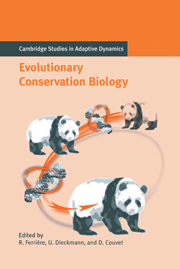Book contents
- Frontmatter
- Contents
- Contributing Authors
- Acknowledgments
- Notational Standards
- 1 Introduction
- Part A Theory of Extinction
- Part B The Pace of Adaptive Responses to Environmental Change
- Part C Genetic and Ecological Bases of Adaptive Responses
- 9 Fixation of New Mutations in Small Populations
- 10 Quantitative-Genetic Models and Changing Environments
- 11 Adaptive Dynamics and Evolving Biodiversity
- Part D Spatial Structure
- Part E Community Structure
- References
- Index
- The International Institute for Applied Systems Analysis
11 - Adaptive Dynamics and Evolving Biodiversity
Published online by Cambridge University Press: 15 August 2009
- Frontmatter
- Contents
- Contributing Authors
- Acknowledgments
- Notational Standards
- 1 Introduction
- Part A Theory of Extinction
- Part B The Pace of Adaptive Responses to Environmental Change
- Part C Genetic and Ecological Bases of Adaptive Responses
- 9 Fixation of New Mutations in Small Populations
- 10 Quantitative-Genetic Models and Changing Environments
- 11 Adaptive Dynamics and Evolving Biodiversity
- Part D Spatial Structure
- Part E Community Structure
- References
- Index
- The International Institute for Applied Systems Analysis
Summary
Introduction
Population viability is determined by the interplay of environmental influences and individual phenotypic traits that shape life histories and behavior. Only a few years ago the common wisdom in evolutionary ecology was that adaptive evolution would optimize a population's phenotypic state in the sense of maximizing some suitably chosen measure of fitness, such as its intrinsic growth rate r or its basic reproduction ratio R0 (Roff 1992; Stearns 1992). On this basis it was largely expected that life-history evolution would always enhance population viability. In fact, such confidence in the prowess of adaptive evolution goes back as far as Darwin, who suggested “we may feel sure that any variation in the least degree injurious would be rigidly destroyed” (Darwin 1859, p. 130) and, in the same vein, “Natural selection will never produce in a being anything injurious to itself, for natural selection acts solely by and for the good of each” (Darwin 1859, p. 228).
The past decade of research in life-history theory has done away with this conveniently simple relation between population viability and evolution, and provided us with a picture today that is considerably more subtle:
First, it was realized the optimization principles that drive the evolution of life histories could (and should) be derived from the population dynamics that underlie the process of adaptation (Metz et al. 1992, 1996a; Dieckmann 1994; Ferrière and Gatto 1995; Dieckmann and Law 1996).
Information
- Type
- Chapter
- Information
- Evolutionary Conservation Biology , pp. 188 - 224Publisher: Cambridge University PressPrint publication year: 2004
Accessibility standard: Unknown
Why this information is here
This section outlines the accessibility features of this content - including support for screen readers, full keyboard navigation and high-contrast display options. This may not be relevant for you.Accessibility Information
- 48
- Cited by
